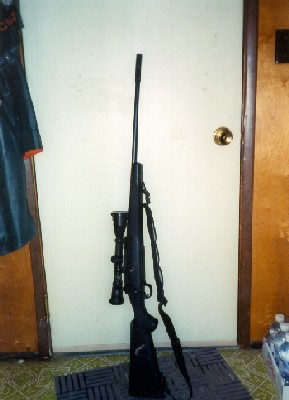Energy…Potential and Kinetic |
|
 My Winchester Model 70
Classic w/ Boss Port, .338 Winchester magnum |
So, lets take a look
at both the potential and kinetic energies of the .338 Winchester magnum.
I will use a load given by the Winchester Reloading manual, which can be
found online at:
This load is a 300 grain bullet, using 59.8 grains of Winchester 760 powder, and this gives a muzzle velocity of 2285 ft/sec. |
For potential energy we know that PE=mgh, where PE= Potential Energy, m=mass, g=acceleration due to gravity, and h=height.
So for a 300-grain bullet, the potential energy is calculated by first finding the mass. To do this, take 300grains/7000grains/pound. This gives you a value of .042857lbs. Then we need to convert pounds to slugs (slugs are the units of mass…) .042857lb/32.2ft/s^2=.001331slugs. Now we can calculate the potential energy of our 300-grain bullet. We will assume that h=six feet, since that is roughly the height of the barrel when I shoot from a standing position. So, since PE=mgh, we get PE=(.00133slugs)(32.2ft/sec^2)(6ft)=.256956lbft. The answer is pretty much nothing and so we can pretty much ignore the potential energy of that bullet sitting at six feet in the air, but now lets look at the Kinetic energy of this bullet when shot. Since this bullet will be twisting when it flies, it will have rotational kinetic energy, but I really don’t want to get into those calculations and from what I have read, the amount of energy given by rotation versus that of the charge behind the bullet is really insignificant so I will only calculate the KE as if the bullet is not rotating. The formula is KE=1/2mv^2. We know the values for m and the muzzle velocity so all we do is plug in numbers, pretty simple! KE=(1/2)(.00133slugs)(2285ft/sec)^2=3472.11ftlbs! That is a lot of energy for that little chunk of lead! So with just a little bit of physics we have calculated the potential and kinetic energies of a .338 Winchester magnum.

